5 Reasons Seawalls Fail and How to Prevent It

Seawalls remain one of the most common shoreline protection measures in Florida. They’re designed to be stable and provide maximum safety and optimal use. However, while protecting your property from coastal erosion, problems may come up that cause instability of the seawall resulting in a failure. This guide takes you through the reasons why seawalls fail and steps you can take to prevent the failure.
1. Seawall Cap Failure
Extended exposure to the elements can corrode the steel used to reinforce the concrete seawall cap. Also, movement of the seawall panels can aggravate the condition also causing the development of cracks on the cap.
The more the steel corrodes and expands, the larger the cracks become. As a result, the cap becomes weak over time potentially allowing the seawall panels to tilt towards the water further breaking the seawall cap as well as potentially the panels.
Solution
You need to replace any failing seawall cap and potentially the panels using a new concrete cap. Make sure and confirm the condition of your tiebacks and replace as necessary.
2. Toe and Berm Failure
This is caused by lack of enough berm/penetration at the bottom of panels, which causes the panels to tilt out, crack, rotate or fracture the cap. As a result, the cap opens a gap between the seawall and dock due to pressure.
Deficiency of berm/lack of penetration is mostly caused by fast water currents, wave action, canal dredging, and rocky soil conditions.
Solution
If the toe-out isn't severe, you may be able to add more rip-rap to alleviate the bottom of the seawall. If the damage is advanced, you may have to replace or pull out the panels.
3. Waterline Failure
Waterline failure is mainly caused by uneven pressure, aged concrete, and corroded reinforcing rods. As a result, panels or slabs may develop cracks along the waterline, which can eventually break the panel along these waterlines.
Solution
The only remedy for advanced waterline damage is to replace the panels, tie-back rods, and cap. But, if the seawall has minor cracks, you can have them repaired to prevent progression.
4. Change in Water Depth Along the Seawall
Canal dredging, waterway lock systems, and strong tides or current are among the ways that affect the water flowing along your seawall, and can lead to change in water depth. Overtime, significant change in water depth can cause seawall failure.
Heavy rains or an increase in water levels can damage the adjacent property and if your seawall's drainage system is inadequate, water can accumulate on the land side of the seawall. This water exerts pressure outwards, which could potentially cause the seawall to fail.
On the other hand, if the water level falls, it can cause imbalanced pressure against the wall, and can also be a potential cause of seawall failure.
Solution
Always pay attention to the occurrences around you that may affect the water level along your seawall. Also, track the water levels on a regular basis to ensure change in the depth of water will not cause the seawall to fail.
5. Severe Weather Conditions
Florida residents experience their fair share of harsh weather conditions that can wreak havoc across the entire state. That's why it's crucial to be prepared since you never know when the next extreme event will strike.
Solution
Prepare for harsh weather conditions by setting up a generator, shuttering windows, and stocking up on supplies. But remember, you need one more thing on your checklist: an expert to inspect your seawall and to confirm it is functioning optimally. This will ensure that any required repairs are handled before the start of the next severe storm.
Living near a waterfront means that you must be prepared for anything and that your seawall needs regular maintenance for stability to be able to withstand the harsh environment and weather conditions of Florida.
Call the seawall experts at Stokes Marine to schedule a professional seawall evaluation.
Topics: FAQDocksStay In Touch
Recent Posts
- The Pitfalls of Prioritizing Cost Over Quality in Marine Construction
- The Ultimate Guide to a Well-Designed Dock: Essential Attributes for Waterfront Living
- Raising Expectations: The Crucial Role of Certified Crane Operators
- Preparing Your Boat and Boat Lift for Hurricane Season in SWFL
- Boat Canopies Vs. Boat Houses for Your Florida Dock: What's the Difference?
